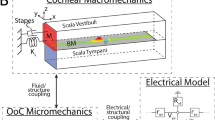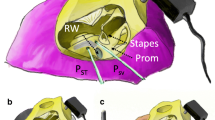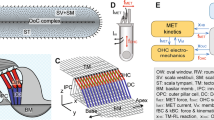Abstract
Sound energy propagates in the cochlea through a forward-traveling or slow wave supported by the cochlear partition and fluid inertia. Additionally, cochlear models support traveling wave propagation in the reverse direction as the expected mechanism for conveying otoacoustic emissions out of the cochlea. Recently, however, this hypothesis has been questioned, casting doubt on the process by which otoacoustic emissions travel back out through the cochlea. The proposed alternative reverse travel path for emissions is directly through the fluids of the cochlea as a compression pressure in the form of a fast wave. In the present study, a custom-made micro-pressure sensor was used in vivo in the gerbil cochlea to map two-tone-evoked pressure responses at distinct longitudinal and vertical locations in both the scala tympani and scala vestibuli. Analyses of the magnitude and phase of intracochlear pressure responses at the primary tone and distortion product frequencies were used to distinguish between fast and slow waves in both the forward- and reverse-propagation directions. Results demonstrated that distortion products may travel in both forward and reverse directions post-generation and the existence of both traveling and compression waves. The forward-traveling component appeared to duplicate the process of any external tone, tuned to the local characteristic-frequency place, as it increased compressively and nonlinearly with primary-tone levels. A compression wave was evidenced at frequencies above the cutoff of the recording site. In the opposite direction, a reverse-traveling wave played the major role in driving the stapes reversely and contributed to the distortion product otoacoustic emission. The compression wave may also play a role in reverse propagation when distortion products are generated at a region close to the stapes.







Similar content being viewed by others
References
Avan P, Buki B, Petit C (2013) Auditory distortions: origins and functions. Physiol Rev 93:1563–1619
Avan P, Bonfils P, Gilain L, Mom T (2003) Physiopathological significance of distortion-product otoacoustic emissions at 2f1-f2 produced by high- versus low-level stimuli. The Journal of the Acoustical Society of America 113:430–441
Cooper NP, Rhode WS (1997) Mechanical responses to two-tone distortion products in the apical and basal turns of the mammalian cochlea. J Neurophysiol 78:261–270
Cooper NP, Shera CA (2004) Backward traveling waves in the cochlea? Comparing basilar membrane vibrations and otoacoustic emissions from individual guinea-pig ears. In: The Association for Research in Otolaryngology 2004 Midwinter Meeting. Daytona Beach, Florida
Dallos P (1992) The active cochlea. J Neurosci 12:4575–4585
de Boer E (2007) Forward and reverse waves in nonclassical models of the cochlea. The Journal of the Acoustical Society of America 121:2819–2821
de Boer E, Nuttall AL, Shera CA (2007) Wave propagation patterns in a “classical” three-dimensional model of the cochlea. The Journal of the Acoustical Society of America 121:352–362
de Boer E, Zheng J, Porsov E, Nuttall AL (2008) Inverted direction of wave propagation (IDWP) in the cochlea. The Journal of the Acoustical Society of America 123:1513–1521
Dong W (2015) Using a third tone to probe the physiological generation site of distortion product otoacoustic emissions in gerbil. In: Karavitaki KD, Corey DP (eds) Mechanics of hearing: protection to perception, the 12th International Symposium. AIP Publishing, Cape Sounio, p. 090007-090001-090005
Dong W, Olson ES (2005a) Two-tone distortion in intracochlear pressure. The Journal of the Acoustical Society of America 117:2999–3015
Dong W, Olson ES (2005b) Tuning and travel of two tone distortion in intracochlear pressure. In: Nuttall AL, Ren T, Gillespie P, Grosh K, de Boer E (eds) Auditory mechanisms: processes and models, the Ninth International Symposium. World Scientific, Portland, Oregon, pp. 56–62
Dong W, Olson ES (2006) Middle ear forward and reverse transmission in gerbil. J Neurophysiol 95:2951–2961
Dong W, Olson ES (2008) Supporting evidence for reverse cochlear traveling waves. The Journal of the Acoustical Society of America 123:222–240
Dong W, Olson ES (2010) Local cochlear damage reduces local nonlinearity and decreases generator-type cochlear emissions while increasing reflector-type emissions. The Journal of the Acoustical Society of America 127:1422–1431
Dong W, Olson ES (2013) Detection of cochlear amplification and its activation. Biophys J 105:1067–1078
Goldstein JL (1967) Auditory nonlinearity. The Journal of the Acoustical Society of America 41:676–689
Goodman SS, Withnell RH, Shera CA (2003) The origin of SFOAE microstructure in the guinea pig. Hear Res 183:7–17
He W, Ren T (2013) Basilar membrane vibration is not involved in the reverse propagation of otoacoustic emissions. Scientific reports 3:1874
He W, Nuttall AL, Ren T (2007) Two-tone distortion at different longitudinal locations on the basilar membrane. Hear Res 228:112–122
He W, Fridberger A, Porsov E, Ren T (2010) Fast reverse propagation of sound in the living cochlea. Biophys J 98:2497–2505
He W, Fridberger A, Porsov E, Grosh K, Ren T (2008) Reverse wave propagation in the cochlea. Proc Natl Acad Sci U S A 105:2729–2733
Henley CM, Weatherly RA, Martin GK, Lonsbury-Martin B (1996) Sensitive developmental periods for kanamycin ototoxic effects on distortion-product otoacoustic emissions. Hear Res 98:93–103
Huang S, Olson ES (2011) Auditory nerve excitation via a non-traveling wave mode of basilar membrane motion. J Assoc Res Otolaryngol 12:559–575
Kale SS, Olson ES (2015) Intracochlear scala media pressure measurement: implications for models of cochlear mechanics. Biophys J 109:2678–2688
Kalluri R, Shera CA (2001) Distortion-product source unmixing: a test of the two-mechanism model for DPOAE generation. The Journal of the Acoustical Society of America 109:622–637
Kemp DT (1978) Stimulated acoustic emissions from within the human auditory system. The Journal of the Acoustical Society of America 64:1386–1391
Kemp DT (1986) Otoacoustic emissions, travelling waves and cochlear mechanisms. Hear Res 22:95–104
Kim DO (1980) Cochlear mechanics: implications of electrophysiological and acoustical observations. Hear Res 2:297–317
Knight RD, Kemp DT (2000) Indications of different distortion product otoacoustic emission mechanisms from a detailed f1,f2 area study. The Journal of the Acoustical Society of America 107:457–473
Knight RD, Kemp DT (2001) Wave and place fixed DPOAE maps of the human ear. The Journal of the Acoustical Society of America 109:1513–1525
Lonsbury-Martin BL, Martin GK (1990) The clinical utility of distortion-product otoacoustic emissions. Ear Hear 11:144–154
Lukashkin AN, Lukashkina VA, Russell IJ (2002) One source for distortion product otoacoustic emissions generated by low- and high-level primaries. The Journal of the Acoustical Society of America 111:2740–2748
Magnan P, Avan P, Dancer A, Smurzynski J, Probst R (1997) Reverse middle-ear transfer function in the guinea pig measured with cubic difference tones. Hear Res 107:41–45
Martin GK, Stagner BB, Lonsbury-Martin BL (2010) Evidence for basal distortion-product otoacoustic emission components. The Journal of the Acoustical Society of America 127:2955–2972
Martin GK, Stagner BB, Dong W, Lonsbury-Martin BL (2016) Comparing distortion product otoacoustic emissions to intracochlear distortion products inferred from a noninvasive assay. J Assoc Res Otolaryngol 17:271–287
Martin GK, Stagner BB, Jassir D, Telischi FF, Lonsbury-Martin BL (1999) Suppression and enhancement of distortion-product otoacoustic emissions by interference tones above f(2). I. Basic findings in rabbits. Hear Res 136:105–123
Mauermann M, Uppenkamp S, van Hengel PW, Kollmeier B (1999a) Evidence for the distortion product frequency place as a source of distortion product otoacoustic emission (DPOAE) fine structure in humans. I. Fine structure and higher-order DPOAE as a function of the frequency ratio f2/f1. The Journal of the Acoustical Society of America 106:3473–3483
Mauermann M, Uppenkamp S, van Hengel PW, Kollmeier B (1999b) Evidence for the distortion product frequency place as a source of distortion product otoacoustic emission (DPOAE) fine structure in humans. II. Fine structure for different shapes of cochlear hearing loss. The Journal of the Acoustical Society of America 106:3484–3491
Meenderink SW, van der Heijden M (2010a) Reverse cochlear propagation in the intact cochlea of the gerbil: evidence for slow traveling waves. J Neurophysiol 103:1448–1455
Meenderink SW, van der Heijden M (2010b) Reply to Ren adn Porsov: reverse propagation of sounds in the intact cochlea. J Neurophysiol 104:3733
Mills DM (2003) Differential responses to acoustic damage and furosemide in auditory brainstem and otoacoustic emission measures. The Journal of the Acoustical Society of America 113:914–924
Muller M (1996) The cochlear place-frequency map of the adult and developing Mongolian gerbil. Hear Res 94:148–156
Olson ES (1998) Observing middle and inner ear mechanics with novel intracochlear pressure sensors. The Journal of the Acoustical Society of America 103:3445–3463
Olson ES (1999) Direct measurement of intra-cochlear pressure waves. Nature 402:526–529
Olson ES (2001) Intracochlear pressure measurements related to cochlear tuning. The Journal of the Acoustical Society of America 110:349–367
Olson ES, Dong W (2006) Nonlinearity in intracochlear pressure. ORL J Otorhinolaryngol Relat Spec 68:359–364
Olson ES, Nakajima HH (2015) A family of fiber-optic based pressure sensors for intracochlear measurements. Proc SPIE 9303
Overstreet EH 3rd, Temchin AN, Ruggero MA (2002) Basilar membrane vibrations near the round window of the gerbil cochlea. J Assoc Res Otolaryngol 3:351–361
Peterson LC, Bogert BP (1950) A dynamical theory of the cochlea. The Journal of the Acoustical Society of America 22:369–381
Ren T (2004) Reverse propagation of sound in the gerbil cochlea. Nat Neurosci 7:333–334
Ren T, Porsov E (2010) Reverse propagation of sounds in the intact cochlea. J Neurophysiol 104:3732 author reply 3733
Ren T, He W, Scott M, Nuttall AL (2006) Group delay of acoustic emissions in the ear. J Neurophysiol 96:2785–2791
Rhode WS (2007) Distortion product otoacoustic emissions and basilar membrane vibration in the 6-9 kHz region of sensitive chinchilla cochleae. The Journal of the Acoustical Society of America 122:2725–2737
Robles L, Ruggero MA (2001) Mechanics of the mammalian cochlea. Physiol Rev 81:1305–1352
Robles L, Ruggero MA, Rich NC (1997) Two-tone distortion on the basilar membrane of the chinchilla cochlea. J Neurophysiol 77:2385–2399
Shera CA, Guinan JJ Jr (1999) Evoked otoacoustic emissions arise by two fundamentally different mechanisms: a taxonomy for mammalian OAEs. The Journal of the Acoustical Society of America 105:782–798
Shera CA, Guinan JJ Jr (2003) Stimulus-frequency-emission group delay: a test of coherent reflection filtering and a window on cochlear tuning. The Journal of the Acoustical Society of America 113:2762–2772
Shera CA, Cooper NP (2013) Basilar-membrane interference patterns from multiple internal reflection of cochlear traveling waves. The Journal of the Acoustical Society of America 133:2224–2239
Shera CA, Tubis A, Talmadge CL, de Boer E, Fahey PF, Guinan JJ Jr (2007) Allen-Fahey and related experiments support the predominance of cochlear slow-wave otoacoustic emissions. The Journal of the Acoustical Society of America 121:1564–1575
Siegel JH, Kim DO, Molnar CE (1982) Effects of altering organ of Corti on cochlear distortion products f2-f1 and 2f1-f2. J Neurophysiol 47:303–328
Siegel JH, Cerka AJ, Recio-Spinoso A, Temchin AN, van Dijk P, Ruggero MA (2005) Delays of stimulus-frequency otoacoustic emissions and cochlear vibrations contradict the theory of coherent reflection filtering. The Journal of the Acoustical Society of America 118:2434–2443
Talmadge CL, Tubis A, Long GR, Piskorski P (1998) Modeling otoacoustic emission and hearing threshold fine structures. The Journal of the Acoustical Society of America 104:1517–1543
van Dijk P, Manley GA (2001) Distortion product otoacoustic emissions in the tree frog Hyla cinerea. Hear Res 153:14–22
Wilson JP (1980) Model for cochlear echoes and tinnitus based on an observed electrical correlate. Hear Res 2:527–532
Yoon YJ, Puria S, Steele CR (2007) Intracochlear pressure and derived quantities from a three-dimensional model. The Journal of the Acoustical Society of America 122:952–966
Acknowledgments
The author thanks Barden Stagner, Brenda L. Lonsbury-Martin, Glen K. Martin, Elizabeth S. Olson, and the reviewers for the helpful comments and discussions on the manuscript. The author also thanks Dr. TianYing Ren for sharing his basilar membrane data. This work was funded by the NIH/NIDCD (DC011506).
Author information
Authors and Affiliations
Corresponding author
Rights and permissions
About this article
Cite this article
Dong, W. Simultaneous Intracochlear Pressure Measurements from Two Cochlear Locations: Propagation of Distortion Products in Gerbil. JARO 18, 209–225 (2017). https://doi.org/10.1007/s10162-016-0602-8
Received:
Accepted:
Published:
Issue Date:
DOI: https://doi.org/10.1007/s10162-016-0602-8




